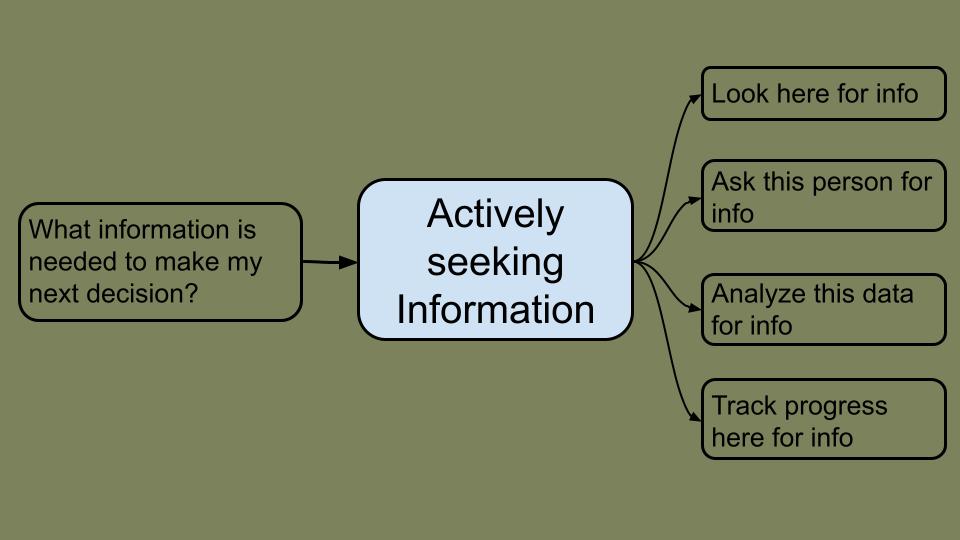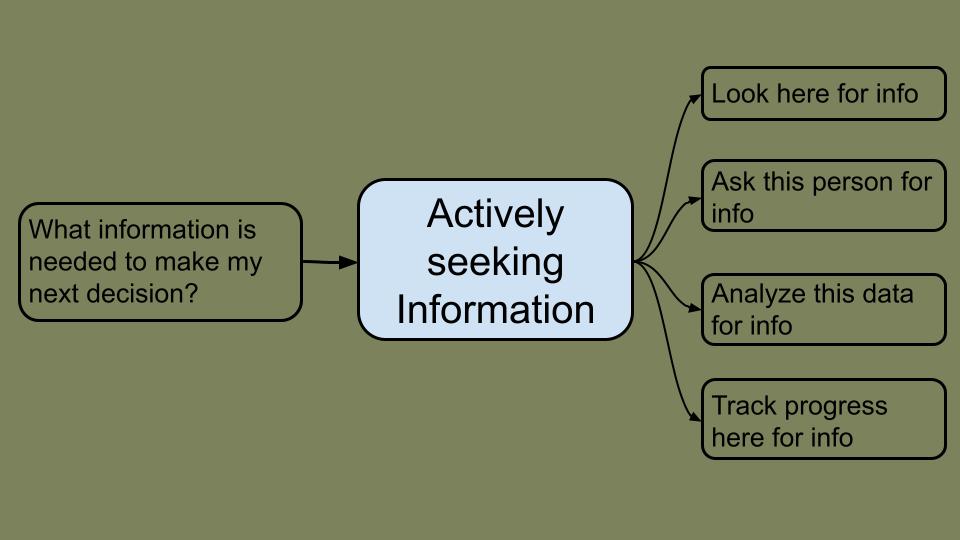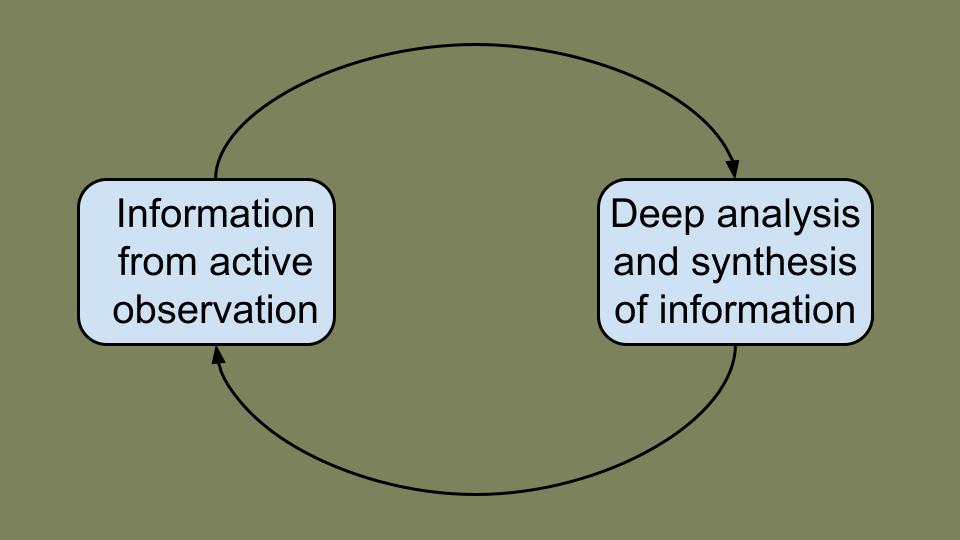Summary:
-
Good decisions are made by people who have done a deep analysis of the most relevant information and who have experience with similar situations.
-
Develop your observation by deliberately seeking the information you need to make the next decision.
-
Develop your orientation or thinking by doing a thorough analysis of all the information you have about the problem and by gaining experience through evaluating and studying similar situations.
WAR
As I was writing the OODA Loop – rapid decision making (I recommend reading that article first), I was constantly thinking about how we can improve our decision making. The foundation is being conscious that the OODA Loop exists. The next step is to deliberately improve your OODA Loop to make it more effective.
The best decision-makers are keen observers with the most highly developed orientation. The next section describes how to become a better observer and how to develop your orientation.
OODA Loop Overview
The OODA Loop is a decision-making process that was developed by Col. John Boyd of the U.S. Air Force. It consists of a four-step process that is constantly cycling to drive all decisions.
The process is:
- Observe – intake information from your environment
- Orient – analyze that information
- Decide – decide on what you need to do
- Act – take the action to make the necessary changes in the environment
To make better decisions, you need to improve your observation and orientation. Those steps drive good decision-making.
Improving Observation
The first step in the OODA Loop is to observe.
Col. Boyd outlined the following inputs for the observation step:
- Unfolding circumstances
- Outside information
- Unfolding interaction within the environment
- Implicit guidance and control

The essence of observation is to take in the most relevant information to make your next decision. The challenging part is identifying what the most relevant information is and setting up a process to monitor it.
Unfolding circumstances
It is first necessary to define “unfolding circumstances” from Google.
Unfolding circumstances:
- Unfold – reveal or disclose (thoughts or information)
- Circumstances – a fact or condition connected with or relevant to an event or action.
They are facts that have been revealed which are connected to an action.
Unfolding circumstances are all the changes happening aside from the direct competition with your competitor. These changes are happening above the tactical level.
Examples of unfolding circumstances in war are:
- Weather
- Operational logistics – how many resources you are burning: gas, food, water, ammo, etc.
- Overall movement of the battle
- Civilians interacting with the environment
- Personnel getting sick or exhausted
As time passes, the environment will keep changing. The world will move on. Some conditions you have control or influence over, some you don’t.
These changes are all inputs into your decision-making. You need to maintain a wide view to track other circumstances that can impact your decision-making. If you can use that information to predict how “unfolding circumstances” will impact the environment better than the competition, your decision-making will be more accurate than theirs.
Unfolding interaction within the environment
The “unfolding interaction within the environment” is the direct contact you are having with your competition.
The key word to define is “interaction”, which from Google is: “reciprocal action or influence.”
Reciprocal is important because it means there is a return of the action. “Unfolding interaction with the environment” is the direct back and forth between you and your competition.
There are a few questions to help frame that interaction:
- What impact are your direct tactics having on your competition?
- How are they responding to your tactics?
- How are they impacting you?
Closely monitoring your competition and how they are responding is vital information for your upcoming decisions. To beat your competition, you need to make better decisions and take bolder action than they do. Monitoring closely what they are doing is probably your most important information.
Outside Information
‘Outside information’ includes facts that are provided to you by someone who is not directly in your organization.
Outside information in war comes from new intelligence reports that have been gathered. This provides an outside perspective. These reports could come from intelligence agencies, foreign governments or local contacts.
Talking to your peers is another great source of outside information. They have often observed many things that you haven’t. The more information that is shared, the faster everyone’s orientation improves.
Implicit Guidance and Control
Everyone has guidance and intent from their leadership, which impacts their decision-making.
In many cases, you will have to make decisions that hurt you but benefit the team. Those circumstances are great examples of implicit guidance and control. You are making your decisions within an overall plan to achieve a team mission; not only to achieve your task.
It is necessary to clearly understand how the team’s mission impacts your decision-making. The more you help the team succeed, the better your long-term outcome will be.
Every decision should be based on trying to achieve the overall mission of the team.
How to improve – Deliberately Observing
You become better at observing, by being very deliberate about it.
When I am performing my best as a decision-maker, I am extremely aware of the next decisions that need to be made. If I am aware of the upcoming decision, it helps me to actively seek the information I need to make the best possible decision.
I perform poorly as a decision-maker, when I’m complacently interacting with my environment and am not looking for specific information. The information comes to me passively. This causes me to hesitate, since I haven’t confirmed or denied the needed assumptions. As a result, I delay or make a less informed decision.
The improvement that I’ve made from trying to improve my observation is summarized in two questions:
- What information do I need to make the next decision. How can I get that information?
If I ask those questions, it puts me in an aggressive information gathering mindset. It drives quality inputs into the upcoming decisions.

The further ahead I confirm assumptions, the more confident I am that I’m making the most informed decision possible. As assumptions get confirmed, decisions are made sooner. It also increases decision accuracy by confirming more of my assumptions prior to making the decision.
Key takeaway: Aggressively monitor for, and seek, the exact information that you need to make your next decision.
Improving Orient
The ‘orient’ step was framed as the ‘thinking’ step. If you are orienting effectively during the OODA Loop, then you are analyzing information quickly and thoroughly.
The inputs that Col Boyd outlined for the orient can be broken down into what needs to be changed in the future and what can be changed now.
Things that can only be changed or mitigated in the long term are:
- Cultural traditions – How have you and your enemy been socialized to approach this decision?
- Genetic heritage – How physically and mentally capable are you compared to your enemy? Are your pre-dispositions an advantage or disadvantage? (exp. risk taker vs. non-risk taker)
- Previous experience – How much experience do you or your team have with similar decisions?
Things we can change right now:
- Analyses and synthesis – How hard have you thought about and processed the possible outcomes involved in this decision?
- New information – Have you analyzed and synthesized all of the new and relevant information or have you ignored and not paid attention to it?
Improving what we can
You can’t immediately change your cultural traditions, genetic heritage and previous experience. However, we can be aware of them and make a plan to mitigate them in the long term.
On the other side, analyses and synthesis, and new information are things you can impact immediately. With these two inputs you can gain an advantage by thinking and working harder than your competition.
.

Example:
Assume that you are in a head to head competition with someone who has the same cultural traditions, genetic heritage and previous experience. In preparation for the competition, you worked hard to analyze all of the information that you had about the competition. You made a detailed plan with all possible contingencies. During the competition you were constantly processing every bit of information to help confirm or adjust your strategy and tactics.
The person you were competing against winged it, with very little preparation. They had a vague plan and no contingencies. During the competition, they tried to process new information. However, without any previous analysis things happened too fast. They couldn’t keep up with your pace or the accuracy of your decision making.
It is clear that previous analysis and synthesis and the continuous processing of new information can give you a distinct advantage.
The thoroughness of your thought about a decision has a major impact on how disciplined, focused and persistent you are. This is immediately translated into an increase in commitment.
The importance of preparation, planning and iterating to success cannot be emphasized enough. It is important to ask whether you took enough time to really think and plan before you made that decision and took action?
There are other actions that can be taken to improve orientation.
The following steps can be taken into account in order to deliberately improve all inputs of orientation outlined by Col Boyd:
- Cultural traditions
- You can’t change your culture and traditions. They were instilled into you by your environment as a youth.
- However, you can be aware of the biases and stay open minded. There are also times when these traditions give you an advantage or a disadvantage.
- You can’t change your culture and traditions. They were instilled into you by your environment as a youth.
- Genetic heritage
- There isn’t much that can be done about your genetics. Some people are big and strong, while others are small and weak. Some are brilliant and can process large amounts of information, while others struggle to make connections between basic concepts.
- You can, however, maximize your genetics. Most of us will never reach our genetic potential. It is possible to be stronger and more fit. You can study harder to develop your brain to solve problems faster and understand concepts better.
- We are limited by our genetics but we probably aren’t at those limits. Consistent study / training along with progressive overload is the only way to move closer to your genetic potential.
- Previous experience
- At the current moment your previous experience is what it is. The next step is to make a plan and work to get the experience and knowledge that you need to become a better and faster decision maker within your desired field.
- Work to get as much direct experience in something as you can. Nothing can replace direct experience. Do this by asking for certain jobs, projects and positions. They must challenge you and help you to overcome a weakness in your experience.
- Find a mentor in the field you want to grow in. Many people are very willing to mentor you if asked. It makes them feel good to help less experienced people.
- Read books from the top experts in the field. Many people have taken the time to share their knowledge with us. You will be able to learn from their experience without having to learn it the hard way like they did.
- Find classes, courses and training in the field you want to become proficient in. Almost every field has formal education that you can enroll in.
- Analyses and synthesis
- We have the ability to impact this immediately.
- Ask yourself, have you closely studied your current problems?
- Have you developed a detailed plan to fix the problem or get the information needed to come up with the appropriate action?
- If you’re approaching a problem, deeply analyzing it will give you a distinct advantage.
- First, it will help you to grow by giving you experience with that problem. You will, therefore, become the immediate expert.
- Second, the concepts you learn by analyzing this problem will help you analyze future problems faster and more accurately and allow you to make connections across many concepts.
- Third, if you have a detailed plan and many contingencies, that plan might still be abandoned. However, since you did the planning, you will be better able to adapt to changing situations.
- We have the ability to impact this immediately.
- New information
- It is important to be open minded about new information. If you have done deep analyses, you will be able to respond to new information that modifies your plan and you can pivot rapidly.
- Identify the sources of new information, so you can pay close attention. During military situations it may be whether your suppression is accurate or if your teams are advancing when they should. In the real world, it could relate to the incoming data or how your customers or competitors interact with the actions that you took. You need to know where to pay attention and be laser focused on the inputs that you receive.
This can be translated into how we develop our observation and orientation in the business world.
BUSINESS
As a business leader, you should be constantly working to develop your observation and orientation skills. The information discussed above applies to both war and business. The quality and quantity of the information and how you process it will determine the accuracy of your decisions. More accurate decisions will lead to more bold actions and more consistent success. The following suggestions will be helpful:
- Know exactly what information you need to make the next decision and actively work to get that information. If you have to make similar, repetitive decisions, set up systems to actively provide you with the data / information you need automatically and consistently.
- Deeply analyze your current business model, problems, opportunities, plans and projects. You should think through all of the possible ways that these things can play out. This understanding will facilitate faster, more adaptable and more accurate decision making.
- Monitor new information closely. This is linked to improving observation. When you get new information, you need to determine what it means and how it will impact your next decision.
- Seek out experiences that make you a better decision maker in your desired field. You can build experience by finding different projects to work on or from actively learning from others. Pursue opportunities that give you the direct experience to develop the decision making you desire. Read the best books in your field and other related fields. Find a mentor in your field and try to learn from them.
- Try to be aware of your cultural biases and genetic gifts. They can have an important impact on your decision making. However, they are usually out of your control. We must be conscious of them, so we can maximize their positive impact.
To wrap this up, to have a faster and more accurate OODA Loop, deliberate development of your orient step and actively observing for information you need to make the next decision is what it takes.
Related Articles:
References:
-
- Boyd, John. “Pattern of Conflict.” ausairpower.net, December 1986, link
- “John Boyd (military strategist)” wikipedia.com, link
- Boyd, John. “The Strategic Game.” ausairpower.net, June 1987, link
- Boyd, John. “A Discourse On Winning and Losing.” coljohnboyd.com, Air University Press, March 2018, link
- Boyd, John. “Destruction and Creation.” goalseys.com, 3 Sept, 1976, link
- Boyd, John. “Organic Design.” ausairpower.net, May 1987, link

0 Comments